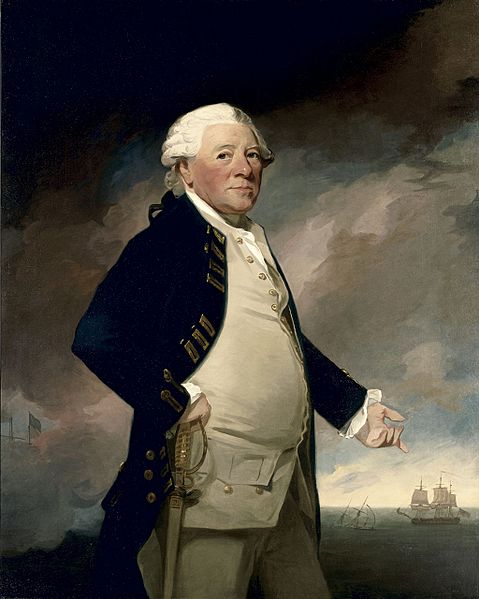Image: Romney Hyde Parker

Description: Caption from the museum's website A three-quarter-length portrait to right wearing vice-admiral's undress uniform 1783–87 and a tie wig. His right hand is on his sword, which is not buckled on, and his left is extended towards the action in the background, which on the left shows the smoke of the Battle of the Dogger Bank, 1781, with Parker's vice-admiral's flag just discernible, while on the right is the sunken 'Hollandia', 64 guns, with his son's frigate the 'Latona', 38 guns, standing by the wreck. (This son, also Hyde, is now best known as Nelson's elderly superior at the Battle of Copenhagen.) Parker entered the Navy at the age of 24 as an able seaman and sailed under Commodore Anson on his circumnavigation of the world, 1740–44. In 1762 when in command of the 'Grafton', 70 guns, in the East Indies, he captured a Spanish treasure ship. As flag officer at the Leeward Islands in 1779 he had a considerable success in intercepting French storeships and privateers. In 1781 he commanded a squadron in the North Sea which intercepted a Dutch convoy of about equal force, which led to the fierce but indecisive Dogger Bank action. On his return Parker blamed Lord Sandwich for the small number and unseaworthiness of his ships. The King tried to pacify Parker and persuaded him to retain his command, to which he replied 'Sire, you have need of younger men and newer ships'. He went as Commander-in-Chief to the East Indies in 1782 but his flagship, the 'Cato', 50 guns, disappeared after touching at Rio de Janeiro on the way out and her fate can only be conjectured. Sittings for the portrait were given in January and June 1782. The artist was an important portrait painter of the late-18th century, generally ranked third after Joshua Reynolds and Thomas Gainsborough. He was in Paris in 1764 and in 1773 moved to Italy for two years, where he became interested in history paintings in the elevated and élitist 'Grand Manner'. This developed into improving upon nature and the pursuit of perfect form. At its best his work demonstrated refinement, sensitivity and elegance, although it could also be repetitive and monotonous. As a society painter he typified late-18th-century English artists who, compelled by the conditions of patronage to spend their time in producing portraits, could only aspire to imaginative and ideal painting. By 1780 Romney's portraits, according to Horace Walpole, were 'in great vogue' and he worked in an increasingly neo-classical style.
Title: Portrait of Vice-Admiral Sir Hyde Parker, 5th Baronet (1714-1782)label QS:Lde,"Porträt des Vize-Admirals Sir Hyde Parker, 5th Baronet (1714-1782)" label QS:Len,"Portrait of Vice-Admiral Sir Hyde Parker, 5th Baronet (1714-1782)"
Credit: http://collections.rmg.co.uk/collections/objects/14404.html
Author: George Romney
Usage Terms: Public domain
License: Public domain
Attribution Required?: No
Image usage
The following 2 pages link to this image:

